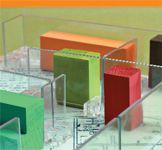What to put inside
Drains and air-return ducts may not seem sexy, but thoughtful choices about behind-the-scenes tools let your new practice work harder for you.
You developed your business plan and made some critical decisions about the floor plan. Now it's time to get down to the nitty-gritty. You need to decide which mechanical systems and plumbing fixtures will become a part of your home-away-from-home. And these items affect your building's operational efficiency everyday. So it's important to choose wisely.

Heating, ventilation, and air-conditioning (HVAC) systems
Heating equipment is divided into three categories: gas-fired, make-up air units (forced air); hot-water-piping systems (boilers); and radiant-heat systems. Of the three, forced air costs the least to install and most veterinary hospitals choose this option. Larger facilities prefer piped-water systems because they're more efficient and provide far greater control.
For cooling, use air-conditioning or evaporative cooling. Air-conditioning systems use forced-air units or chilled-water piping. Most people remember evaporative-cooling as those little boxes on top of desert houses. However newer commercial systems combine evaporative-cooling with air-conditioning in a single unit to supply the most energy-efficient cooling possible.
Veterinary facilities consume quite a bit of energy because they require a high rate of air exchange. Using energy-recovery equipment as part of your heating, ventilation, and air-conditioning system helps control energy costs. Specific systems range in efficiency from heat-wheel exchangers and air-to-air exchangers to closed-loop refrigerant systems. With current energy costs, you generally recover your initial installation costs in seven to 10 years.
When discussing mechanical systems with your architect, don't forget to talk about the different types of thermostatic controls, what rooms they control, and their locations.
Drainage systems
An effective drainage system makes the runs easy to clean, using minimum staff time and effort. No matter which approach you choose, the floor must slope toward the drain at a minimum of 1/4 inch per foot. I also suggest that you oversize both the drains and the piping to reduce long-term maintenance problems. Options for drainage systems include:
- Individual drains in each run. This approach provides optimum disease control and, in areas with fewer than a dozen runs, it's often the least expensive. One drawback: Successful installation requires complex and exacting work when you install the floor slab.
- Trench drains. It's easier to build a single floor slope towards a continuous drain. However, you get less disease control because the drain connects to each run. Trench drains also tend to be thoroughly cleaned less regularly, so they might build up residue and odor. For optimum performance, install a trench drain on both sides of the guillotine door.
You also need to install a flushing system with a water line stubbed into either end of the trench. When solid wastes need to be washed down the drain, you simply open a valve. This approach works well, but only if you use an adequately sized line and a ball valve that opens quickly.
A concrete subcontractor can form your trench drains on site, or you can use a prefabricated corrosion-resistant polymer concrete unit and grate. However, in my experience, pre-formed drains typically result in a higher-quality installation.
- Area drains. With this system, a large square drain centered under the guillotine door allows you to wash both sides of the run into a single drain, halving the number of drains.
Cleaning systems
- High and low-pressure cleaning systems with flow-monitoring injection pumps for chemical disinfectant clean runs, cages, and equipment effectively. And quick disconnects used with spray wands or hose reels that are mounted to the ceiling make the spray-and-wash system easy to use.

High-pressure systems have drawbacks though. They aerosolize waste and propagate air-borne disease. And it's possible that the speed of cleaning may not give the disinfectant long enough to work.
- Commercial washers and dryers are often highly requested. While efficient in terms of staff time, water, and power usage, these units cost significantly more—about $4,000 each—and require more space for clearance and access. And keep in mind, if you build a laundry room larger than 100 square feet, you must install a fire sprinkler.
- Central vacuum systems make a practical addition to veterinary facilities due to innovations like kick-plate inlets. To include this option, you'll need convenient hose storage closets and about six feet of wall space in a utility room.
Scrub sink faucets
- Infrared faucet and thermostatic mixing valve. An infrared faucet turns water on and off when hands enter and leave the lavatory bowl. The pre-set mixing valve delivers water at the temperature you specify. You need electrical power to operate this feature.
- Knee-action or foot-action faucet valves, on the other hand, allow manual operation with either the knee valve mounted to the back wall or the foot valve on the floor. But these options don't work with a scrub sink installed in a cabinet.
And a few more
- Eyewash stations. To save money and space, use the faucet-mounted personal laboratory eyewash rather than a wall-mounted sink unit to fulfill this code requirement.
- Grooming tubs. The least expensive option is using a residential style tub as a platform. However, when you consider durability, maintenance, and ease of use, pre-manufactured units may be more economical long-term. To minimize maintenance, install an accessible, commercial-grade hair trap.
Lawrence A. Gates is a senior partner of Animal Arts/Gates Hafen Cochrane in Boulder, Colo., a firm that has designed more than 300 veterinary hospitals and more than 40 animal shelters. Please send questions or comments to ve@advanstar.com

Lawrence A. Gates
Planning for technology
Technology that universities and human hospitals started adopting 10 years ago is finding its way into veterinary hospitals today—and the new systems may change your design.
You may not build in every hot new accessory, but technology has become pervasive. And you do need to think about the systems you'll use today and down the road. Evaluate the usefulness, effectiveness, and cost of each device. Then think about space, hardware, software, wiring, and how your systems will interact with each other.

As systems become more complex, you may want to consider hiring expert systems integrators to help coordinate telephone, computer, automation, information technology, audio/visual, diagnostic, imaging, treatment, fire, and security systems. As the owner and end user, you need to know enough about what you want to communicate your needs to your architect.
Some do's
Consider the following suggestions when you're planning for technology in your new facility:
- Be flexible. The one sure thing about technology is that it'll change, so wherever possible, allow for flexibility in the construction of your new facility.
- Allow for required clearances. Some equipment has particular space needs. And don't just think about where it'll sit once it's installed. You need to move it into place, too.
- Check with your equipment provider before finalizing design clearances for both the horizontal and vertical dimensions. Oversized doors and hallways help a lot when you're installing large equipment.
- Plan for distribution. You may need to build in supplemental distribution points—in addition to your central computer and telephone room—to run all the phone and computer cables you need through the practice efficiently and cost effectively.
- Allow for environmental conditioning. Technical equipment, including computer and imaging equipment, generates a significant amount of heat. So consider the load on your air-conditioning system. Get heat load information from your equipment manufacturers or suppliers, and give it to your HVAC engineer.
Know how much power your equipment requires. Adding more power later can be very expensive. So talk to your equipment supplier to find out how much power you'll need, and then adjust your feeder and panel size to accommodate both immediate and future power needs.
- Plan for the unseen. Certain pieces of equipment, such as linear accelerators, have shielding requirements that you need to consider in your design. Another example: You can't use ferrous metal within a specified range of an MRI unit. In both cases, you need to make accommodations for unseen rays and electromagnetic fields.

Technology you'll want
The following examples, from a nearly limitless list of possibilities, show a range of current and near-future technological advances. Here's the impact each technology could have on your design.
- Interactive multi-port computer and data systems. Paperless practices use systems that facilitate the free exchange and input of medical record information between multiple data-entry points. These network systems also offer business-management capacities like scheduling, invoicing, and inventory control. Using computer stations or laptops, doctors and their staff members can instantaneously access any patient data. Digital lab results and images also become part of the electronic file.
- Mobile computers reduce or eliminate the need for stationary computers. A couple of downsides: Wireless systems sometimes experience signal interference and dead spots. And it's difficult to secure information broadcast in and around the facility.
- AV/IT interactive systems. More advanced network systems can now transmit video camera imaging onto any computer monitor. So you could use video cameras to display live and taped images from an endoscopic camera, a digital radiograph unit, or an overhead camera in the operating room, for example. You can also use these systems for monitoring patients or building security. You could feed this data to conventional computer monitors or large flat-screen wall monitors. And you could use the video for internal continuing education or to set up displays in public areas for client viewing.
- Digital radiography. Digital radiography equipment only recently became more affordable for veterinarians. And while I don't expect auto-processors to disappear any time soon, clearly the convenience of storing and accessing digital radiograph images is on the rise. The advantages: greater resolution, instantaneous developing, no messy processing, and the ability to transmit images over the Internet. And you don't need to build a separate darkroom.
- Security systems. In this day and age, most businesses build in security systems. You may have intruder, smoke, and fire alarms, or battery-powered, push-button door locks. You could even install systems that monitor the location of people anywhere in a building.
While retinal and fingerprint scanners have a long way to go before they're foolproof and affordable, a battery-powered door lock is an easy way to manage the security of any business that has employee turnover. Rather than managing numerous keys or re-keying when a disgruntled employee quits, you can just reprogram the push-button door lock.